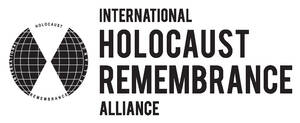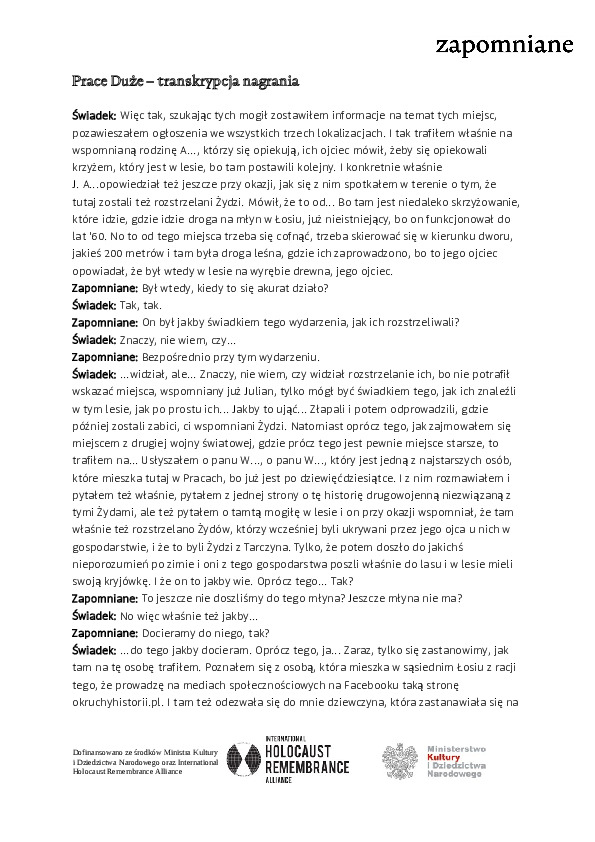Prace Duże
Borough of Tarczyn , Warszawski District, Mazowieckie VoivodshipType of place
Forest (robinia pseudoacacia)Information about the crime
In June 2022, we came to Prace Duże for the first time at the invitation of a local regional historian, who, on the occasion of his research on war graves from the January Uprising and the II World War, obtained information on crimes against Jews in the forest.
Thanks to his help, we met with several residents from the immediate area who knew the story from family accounts.
When a glassmaker from nearby Henryków was walking in the woods as a child, he came across several large field stones. He asked a woman from the nearest house what they could mean. She told him that it was a cursed place. Jews had been killed in the forest.
Julian A. of Prace Duże knew about the execution from his father, who at the time was logging in the forest and heard the shots. He does not know the grave’s exact location, but he indicated the forest area where it was located.
Andrzej J. from Łoś is the son of a miller who took over the mill in Łoś immediately after the war. When farmers brought grain to the mill, they shared various stories, including war stories. There, Mr. Andrzej’s father heard a story about a group of Jews, among whom were men, women and children (a total of 6 people), who were hiding in a dugout near the old mill on the Tarczynka River (the ruins of the mill are less than a kilometer from where the Jews were probably buried). There was also a story about gamekeeper B. supplying food to Jews in exchange for valuables. When the Jews ran out of it, he turned them into the Germans.
“There were probably three men or three women and two children. And two children,” he said. They were dragged out of there because a local gamekeeper stopped a German car driving down the road on the way to Tarczyn. He stopped the Germans and informed them that Jews had been hiding there for several months.
FZ: What year was that?
– Well, after the ghetto. I guess they were escapees from the ghetto.
FZ: From the ghetto in Tarczyn?
– Either in Tarczyn or in Warsaw. Anyway, they were refugees. They camouflaged themselves quite well here; they supposedly had a nicely arranged dugout”. (Prace Duże, date)
We also reached out to the oldest resident of the village, Mr. W., but unfortunately, due to age and illness, he was unable to tell us much except that there were indeed Jews hiding there, and they died in the area. Luckily, his son remembered that during mushroom-picking expeditions, his father showed him a spot in the woods where the murdered Jews were buried. Supposedly, there were five people of both sexes. The son remembered that acacia trees grew there. The location is within the area indicated by Julian A. and Andrzej J.
“Father told us that the Germans came and found these Jews. They brought the whole family here, five people. They also brought two men, who they told to dig a hole here and bury them. That’s how it was. And that’s all I know about it”. (Prace Duże, date)
There are accounts of three residents of Prace Duże who testified before The Regional Commission for the Examination of German Crimes in Warsaw in 1973. The location of the original documents is unknown. Still, a German translation has been preserved in the collection of The Central Office for the Investigation of National Socialist Crimes in Ludwigsburg, which has been made public in the form of scans to the Pilecki Institute under appropriate agreements.
Edward R., Antoni R. and Jozef G. testified that in the spring (Antoni R. said it happened after the year of occupation. The others did not remember the year), the Germans, accompanied by the village chief, came for them and led them to a place in the young forest 1 km away, where the bodies of three men, a woman and a girl (12-13 years old) who had recently been killed lay. Two pits were dug, one for the men, the other for the woman and the girl. According to this account, the Jews were supposed to come from Tarczyn, and German military policemen were also supposed to be stationed there. The testimony also mentions that when the diggers arrived at the site, in addition to the Germans, there was also the gamekeeper B., whom we heard about from Andrew J.’s story.
In addition, Edward R. mentions that the Germans amused themselves by shooting at a nearby oak tree like a target.
In the place Mr. W.’s son showed us, the acacia grove is surrounded by mature oak trees.
Transkrypcje
Contact and cooperation
We are still looking for information on the identity of the victims and the location of Jewish graves in Prace Duże. If you know something more, write to us at the following address: fundacjazapomniane@gmail.com.
Bibliography
IPN_GK195/XV/7 slides 11-22
Recording of the Zapomniane Foundation (audio recording), Jakub C., interviewed by Andrzej Jankowski and Agnieszka Nieradko, Kłudzice, July 23, 2021.
We have collected the materials about this village thanks to the funding provided by the International Holocaust Remembrance Alliance as part of the project “The rural Holocaust. Collecting and safeguarding the never recorded testimonies 100 forgotten Jewish graves 2021-2022”

 Prace Duże zdjęcie lokalizacji
Prace Duże zdjęcie lokalizacji Prace Duże - transkrypcja 1
Prace Duże - transkrypcja 1